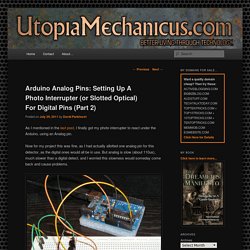

Arduino Analog Pins: Setting Up A Photo Interrupter (or Slotted Optical) For Digital Pins (Part 2) As I mentioned in the last post, I finally got my photo interrupter to react under the Arduino, using an Analog pin.

Now for my project this was fine, as I had actually allotted one analog pin for this detector, as the digital ones would all be in use. But analog is slow (about 110us), much slower than a digital detect, and I worried this slowness would someday come back and cause problems. So I looked at the circuit I was using, and realized something: the analog output value of 200 was quite low. I was thinking of 255 as the upper limit for analog, but in fact it runs from 0-1023. This means that 200 was about 20% of a full signal, and possibly that was why I couldn’t get a digital reading. Untitled. DIY High Impedance Preamplifier w/2N3904. 12V Solenoid Valve f Arduino High Speed Photography Water Drop Collision Droplet. Schematics. Triggering a Camera’s Flash with Sound and Light. Update: Check out my latest Camera Axe project for a much more robust device that handles this or my store where I sell the Camera Axe.

For those just wanting to see the pretty pictures, click here. This article focuses on making the sensors used to trigger a camera’s flash using a microphone or a cheap laser pointer. Since I’ve already described how to do the actual firing of a camera’s flash here I won’t focus on that part of this project today. There are a lot of places on the web that describe how to trigger a flash with an electrical circuit, but I feel that using a microcontroller like Arduino offers big benefits. For instance you can easily add new sensors, or even run multiple sensors at once. Photo Gate Example Circuit.